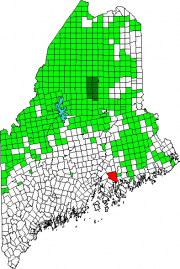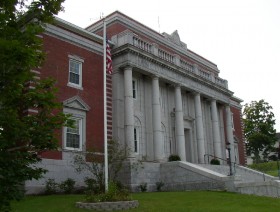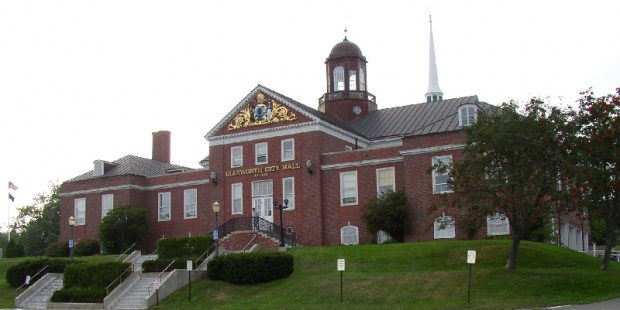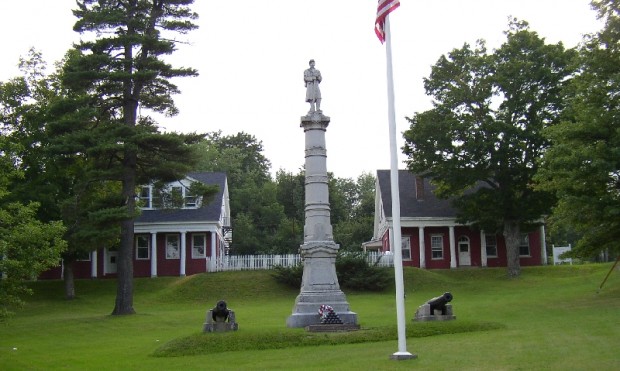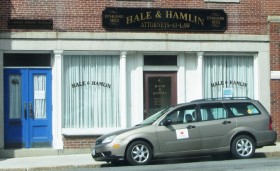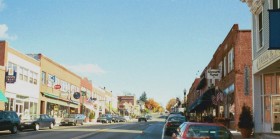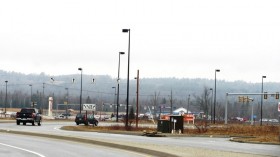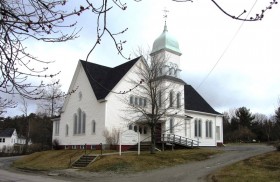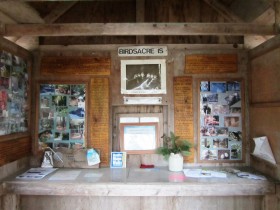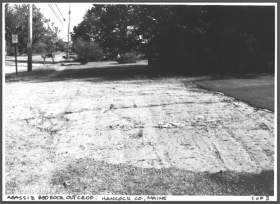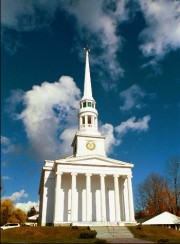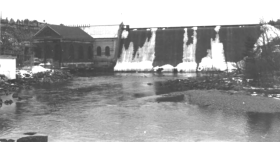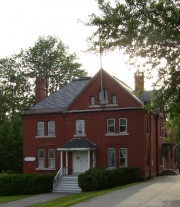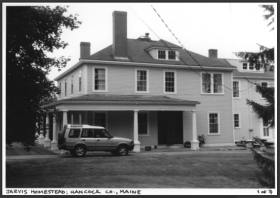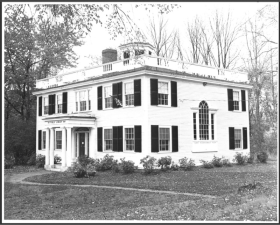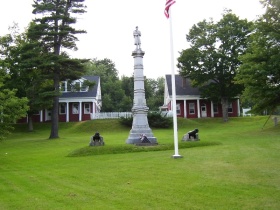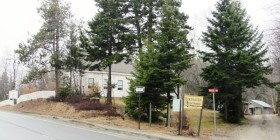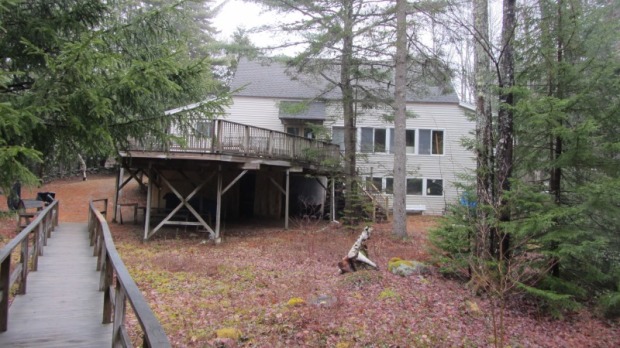
| Year | Population |
|---|---|
| 1970 | 4,603 |
| 1980 | 5,179 |
| 1990 | 5,975 |
| 2000 | 6,456 |
| 2010 | 7,741 |
| Geographic Data | |
|---|---|
| N. Latitude | 44:35:09 |
| W. Longitude | 68:29:46 |
| Maine House | District 132 |
| Maine Senate | District 7 |
| Congress | District 2 |
| Area sq. mi. | (total) 93.8 |
| Area sq. mi. | (land) 79.3 |
| Population/sq.mi. | (land) 97.6 |
| County: Hancock
Total=land+water; Land=land only |
|
[ELS-worth] is a city in, and the county seat of, Hancock County, incorporated as a town on February 26, 1800 from Plantation Number 7. The new community was named for Oliver Ellsworth, a Massachusetts delegate to the Constitutional Convention in 1787. From 1809 through 1852, it annexed land from Dedham, Surry, and Trenton.
The incorporation of Ellsworth as a city on February 27, 1869 made it one of the three largest cities by area in Maine, the others being Caribou and Presque Isle.
Settled in 1763, the community has relied on lumbering, shipbuilding, and industry to support its economy.
A fire set by an arsonist on May 7, 1933 destroyed the business district and over 100 homes. See the amateur film of the fire’s aftermath from Northeast Historic Film.
Ellsworth is the birthplace of 19th century member of Congress and Maine Supreme Court justice John A. Peters, and of his nephew John Andrew Peters, who also served in Congress in the early 20th century. It is also the birthplace of Congress member and U.S. Senator Eugene Hale, a founder of law firm Hale and Hamlin, and Hancock County prosecuting attorney.
The classic Grand Theater, now the Grand Auditorium, has been saved as a movie and performance space downtown.
Former editor of the Washington Post, James Russell Wiggins, published the Ellsworth American newspaper from 1966 to 1991.
Virtually all travelers from the west and north heading to Acadia National Park, or other points “Downeast,” pass through the city. Lying just south of Graham Lake, on which it has substantial frontage, Ellsworth is at the junction of U.S. Route 1 with Maine Routes 3, 172, 179, 180, 184 and 230.
As a result, the city is a shopping center for the area and summer tourism. For many years the commercial strip, from Main Street to the route noted above, opened into the Bar Harbor Road with scattered “tourist traps” along the way.
In 2013, the commercial strip abuts a huge, sprawling complex of shopping malls and multi-lane highways with a sometimes confusing collection of signs and one-way streets.
Another magnet is the Col. John Black Mansion, a modified Georgian design home to the land agent for William Bingham. Part of the Ellsworth landscape for 175 years, it was once home to three generations of the Black family and is now an historic house museum and public park. It is both an architectural gem and a cultural statement. Built between 1824 and 1827 by Colonel John Black, this stately brick house, based on a published design by American architect Asher Benjamin, contains the original family furnishings of one of Eastern Maine’s most distinguished families.
Birdsacre Sanctuary is a 200-acre woodland with trails and ponds adjacent to pioneer ornithologist Cordelia J. Stanwood’s family home, with furnishings and her collection of mounted birds.
Ellsworth Falls has been a power source for the area for many years. According to Edward Stem,
The 85 foot drop through the cascades at Ellsworth Falls to the head of the tide was an ideal location for mills and dams, and enterprising businessmen built no less than seven dams here. Ellsworth and Ellsworth Falls at one time hosted a total of thirty-seven mills: . . . .
Born here in 1898, baseball player Curtis Hooper “Curt” Fullerton began his Red Sox career in 1921. He was with the Sox until 1925, then made a brief comeback in 1933. A pitcher, his record was 10 wins and 37 losses, with an ERA of 5.11.
Richard Edward “Dickie” Scott was born in Ellsworth in 1962. A former infielder, he played 10 seasons in the Yankees and Athletics organizations, appearing in three regular season games with the 1989 World Champion Oakland Athletics. He spent a season as the Houston Astros’ Minor League Field Coordinator and was the Toronto Blue Jays’ Director of Player Development from 2001-2009. Named the 1994 Minor League Manager of the Year by USA Today Baseball Weekly, he also earned Arizona League Manager of the Year honors in 1991, and was the Northwest League Manager of the Year in 1992 and California League Manager of the Year in 1994.
Form of Government: Council-Mayor-Manager.
More Videos!
Additional resources
American National Red Cross. The Ellsworth and Auburn, Maine, Fires of May, 1933: official report of relief operations of the American National Red Cross. 1933.
Beem, Edgar Allen. Ellsworth: Commercial and Cultural Crossroads of Down East Maine. Camden, Me. Down East Enterprise. 1984. [University of Maine, Raymond H. Fogler Library, Special Collections]
Conners, Scott. Ellsworth, Maine 1902-1912: An Original History. 1983.
Cunningham, Agnes H. History of Ellsworth, 1763 to 1910. A. H. Cunningham. 1935.
Davis, Albert H. History of Ellsworth, Maine. Lewiston, Me. Lewiston Journal Printshop. 1927.
Eliason, Axel, Mrs. The Black Mansion, Ellsworth, Maine. Ellsworth, Me. 1928?
The Ellsworth Dam on the Union River at Ellsworth, Maine. Whitefish, MT Kessinger Publishing. 200-?.
*Maine. Historic Preservation Commission. Augusta, Me. Text and photo from National Register of Historic Places: http://pdfhost.focus.nps.gov/docs/nrhp/text/xxxxxxxx.PDF, http://pdfhost.focus.nps.gov/docs/nrhp/photos/xxxxxxxx.PDF
Rubin, Adam. “Staff hirings official.” ESPN New York. December 10, 2010. http://espn.go.com/blog/new-york/mets/tag/_/name/dick-scott (accessed October 12, 2012)
Salisbury, Deale B. Ellsworth, Crossroads of Downeast Maine: a Pictorial Review. Virginia Beach, VA Donning Company. c2005.
Special Illustrated Booklet of Ellsworth, Maine: compiled for the Hancock County Fair Association as a souvenir program of the historical pageant presented by them July 22 and 23, 1925, by the John B. Rogers Production Co. 1925. [University of Maine, Raymond H. Fogler Library, Special Collections]
Springer, Darlene. The Great Fire of Ellsworth, 1933. Salt Lake City, Utah. Aardvark Global Publishing. c2008.
Stem, Edward. Lumbering & Coasting: Ellsworth, Maine and the Schooner Storm Petrel. College of the Atlantic. April 2003. https://archive.org/stream/lumberingcoastin00edwa/lumberingcoastin00edwa_djvu.txt (accessed March 11, 2014)
National Register of Historic Places – Listings
Photos, and edited text are from nominations to the National Register of Historic Places researched by Maine. Historic Preservation Commission.
Full text and photos are at https://npgallery.nps.gov/nrhp
Agassiz Bedrock Outcrop
[406 State Street] The Agassiz Bedrock Outcrop is a rounded, polished and exposed area just east of Ellsworth falls on Route 1A (State Street) in Ellsworth. The outcrop exhibits pronounced grooves that were molded by glacial ice moving across the face of the rock from northwest to southeast. This rock is described by Professor Louis Agassiz of Harvard University in his 1867 ground breaking work “Glacial Phenomena in Maine” as demonstrating the presence of glaciers over the entire state during the Pleistocene era. As one of the physical inspirations for Agassiz’s revolutionary theory, this bedrock outcrop symbolizes a major landmark in natural science, geological thinking and is a monument to modern scientific thought.
From 1838 to 1875 geologists and natural historians debated the origins of glacial markings on rock outcroppings in northern New England. [See the Silsby Plain and the Whaleback in Aurora.] Beginning in 1859 a Rockland physician, John DeLaski, began to think that the modifications of the Maine landscape were caused by grinding at the base of a great ice sheet which covered all of Maine. DeLaski worked very slowly and critically, mostly around Penobscot Bay and published his hypotheses in 1864. That autumn Professor Louis Agassiz of Harvard College, the greatest naturalist of his day and father of the Ice Age concept, visited Maine on vacation where he observed similar evidence to that reported by DeLaski. Agassiz published his detailed findings in The Atlantic Monthly in 1867, and in a book several years later.* [Christi Mitchell photo]
Black Mansion
[West Main Street (Maine Route 172)] See photo and text above.
Ellsworth City Hall
[City Hall Plaza] Ellsworth City Hall is architecturally significant as a variation of Georgian Revival design uncommon to Maine. This distinctive 1935 landmark maintains a commanding location in Ellsworth’s downtown and symbolizes the city’s reconstruction after a devastating 1933 fire.* [See photo above.]
Ellsworth Congregational Church
[State Street] The 1846 Ellsworth Congregational Church is an impressive Greek Revival structure. The large scale and the plain boldness of the detail is appropriate to a building of such huge size. The church is well sited on a raised platform of ground on the side of a gently sloping hill. The approach up the hill toward the front of the church emphasizes the soaring vertical nature of its facade.
One of the buildings to survive the 1933 fire, the Church remains a fine example of New England church architecture of the mid-nineteenth century.*
Ellsworth Power House and Dam
[Union River] This complex, less than one mile from downtown, is one of the oldest “peaking” facilities in the state and has a unique design. The dam is a hollow Ambursen type. It consists of two thin steel reinforced slabs of concrete suppored by concrete buttresses built at fifteen foot intervals. The dam is the highest of its type and the granite ledge on which it sits insures longevity. The distinguished engineer of the project, James T. Leonard, wrote a report in 1928 which contains the following colorful description:
Owing to the natural beauty of the surroundings, the great height of the dam, and the architectural features of the power house, the Ellsworth station is undoubtedly the handsomest power station in New England. The dam and power house are located between two rugged granite bluffs rising almost perpendicularly to a height of nearly one hundred feet above the bed of the river; between these primeval ledges stretches a massive dam of concrete and steel, rising seventy-one feet above the bed rock, the highest power dam in New England.* [Frank A. Beard photo]
Grand, The
[Main Street] Five years after the 1933 fire, a brick commercial block was erected by the City in order to foster economic recovery. Known as The Grand, the one-story block on upper Main Street contained five steel and glass storefronts and a recessed lobby that lead to a 730 seat auditorium. Dedicated initially to screening motion pictures, the interior of the theatre features Art Deco motifs executed in patterned painted wood and tile, and streamlined trim.
The overall exterior reflected current storefront design and materials. However, the marquee and 20 foot tall sculptural tower of stainless steel and Vitrolite glass marking the entrance to the theatre is an extraordinary example of Art Deco/Modern design. Its reputation as the town’s most important venue for cinema and performing arts, along with its design, makes it a significant historic property.*
Hancock County Jail
[40 State Street] The 1886 Hancock County Jail functioned as an incarceration facility and a residence for the Sheriff or jail keeper’s family. The Queen Anne style building with Renaissance Revival details was designed by the Portland architect Francis H. Fassett.
The front half of the facility is a comfortable residence featuring period detailing, while the back half contains fourteen small granite cells on two levels. Small openings in the dividing wall between the two sections allowed the jailer to monitor prisoners or pass provisions from the kitchen to them. Construction was by J. & J. Philbrook of Lewiston and the building opened in April of 1886. It housed inmates through the mid-1970s and is now home to the Ellsworth Historical Society.
Jarvis, Col. Charles and Mary Ann, Homestead
[10 Surry Road] The Jarvis Homestead is a stately, late-Federal era residence associated with one of the most important families in the Ellsworth region during the mid-19th century. Since its construction in 1828, it has been the residence of individuals who have influenced state and local history. Charles Jarvis was active in establishing the boundaries of the town and the nation; while his daughter Ann pushed the boundaries of acceptable roles for women in business and medicine.
Within a few years of building the house, Jarvis entered Maine politics. He was elected to the Maine House of Representative for four terms between 1832 and 1835, in 1836 he was a member of the Maine Senate and again was elected to the House in 1844.
In the late 1830s Jarvis became involved with the Aroostook territory. He reportedly built the famous military road that ran about one hundred miles through the wilderness between Mattawamkeag and Houlton. In February of 1839, he became involved with the “Aroostook War.” At the time land agent Rufus Mclntyre and two associates were arrested by a provincial force from New Brunswick and British troops were massing near the boarder. Governor Fairfield appointed Col. Jarvis provisional land agent. Jarvis immediately proceeded to the Aroostook River and named Joseph Parker to be the Colonel of volunteers under his direction. The disputed area was resolved by the Webster-Ashburton Treaty in 1843.
In 1854, his influence was called upon to quell a disturbance involving a local priest, Father Bapst, who was assaulted by a crowd of Know Nothings in Ellsworth. Bapst was tarred and feathered and threatened with death. Jarvis provided him refuge in his house, after which Bapst returned to Bangor.
Hannibal H. Hamlin, son of the Vice-President of the United States under Lincoln, Hannibal Hamlin, purchased the Jarvis property in 1926 . An accomplished lawyer, judge, and member of the Maine Senate and House of Representatives, Hamlin also served as Attorney General between 1905 and 1908.* [Christi Mitchell photo]
Jordon, Col., Meltiah, House (The Library)
[State Street] This Federal style house was built by Colonel Meltiah Jordan, born in Biddeford in 1753, the descendant of a minister in the Church of England who had come to Maine. Jordan came to Ellsworth in 1775 to work for Berwick merchant, land and mill owner Dr. Ivory Hovey. Jordan purchased the doctor’s estate and ran a business until 1789, when he was appointed Customs Collector of Frenchman’s Bay. In 1817, shortly before his death, Jordan built the house, now the library, for his son, Benjamin. Benjamin sold the house to Seth Tisdale, who became one of the town’s leading citizens and builder. He was also a shipbuilder, including the 1,800 ton Horizon, largest ship built in Ellsworth. He lived in the Jordan House until his death in 1875. In 1897, George Nixon Black, a native of Ellsworth but resident of Boston, purchased the house to remodel it as a library. On completion in January 1898, it was presented to the town.* [MHPC photographer not attributed]
Old Hancock County Buildings
[ Cross Street] The Ellsworth Community Building and Alumni Association Building are a handsome, pair of rectangular one and a half story Greek Revival style municipal buildings . The former was built around 1834 and the latter, as a detached addition, in 1838. Both draw inspiration from their style and each features colonnades in the Doric order on the front and rear facades. The roofs are gabled. Both have granite foundations.
The buildings housed Hancock County offices after the shire town was moved from Castine to Ellsworth in 1838. As the county grew the buildings were no longer large enough to serve the need. In 1885 the county conveyed the property back to the City of Ellsworth.
The buildings have served as a high school, a summer school for Boston University, a community center, and other assorted purposes. Located on Bridge Hill, they look down across a park and the Union River at the business center of the City of Ellsworth.*
Stanwood Homestead
[1 mile South of Ellsworth on Maine Route 3] Captain Roswell L. Stanwood built the Homestead in 1850 on the foundation of a smaller 1830s dwelling owned by his uncle, Peleg Stanwood. The Cape Cod house is very much as it was when built. Pioneer ornithologist Cordelia Stanwood, born in 1865, was a descendent of Col. William Stanwood, on General Washington’s staff during the Revolution, who donated much of the Bowdoin College campus land.
Her lasting achievements were as a self-educated naturalist, contributing greatly to ornithological study in Maine for fifty years. As a writer and photographer, her material was widely used by other bird researchers. Bowdoin’s Dr. Alfred O. Gross noted that her life histories of birds were the best any Maine person had written. Her portrait was presented to the Library of Congress by the American Ornithologists Union in 1934.*
Whiting, Samuel Kidder House
[214 Main St] The Whiting House is probably the finest Second Empire style building in Hancock County. Unusually well-preserved, the interior is among the best restored of any accessible to the public in eastern Maine. Samuel Kidder Whiting (1853-1917), an Ellsworth dry-goods merchant, commissioned the house at the age of 18 and lived there until his death. The second owner was Benjamin B. Whitcomb, a lumber operator and the town’s largest employer during and after World War I.
The house is sophisticated and probably architect-designed since a virtually identical but slightly more expensive house is on West Broadway in Bangor, the Charles P. Brown House. The only architect practicing in Bangor at the time was George Orff, and the restrained but elegant character of the plan is wholly in keeping with his style. Orff was a major Maine architect, and this is the largest commission attributable to him outside of Bangor.



